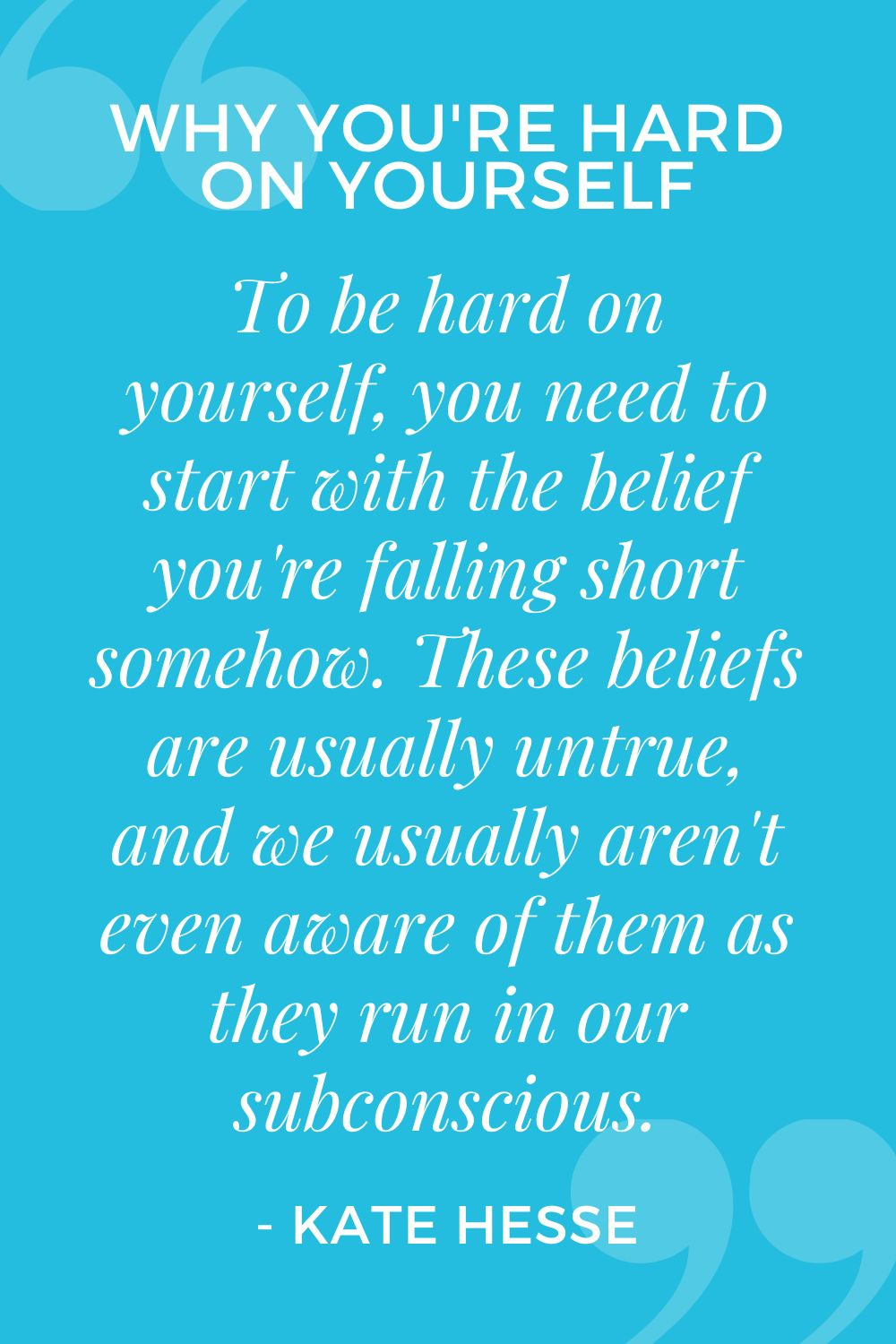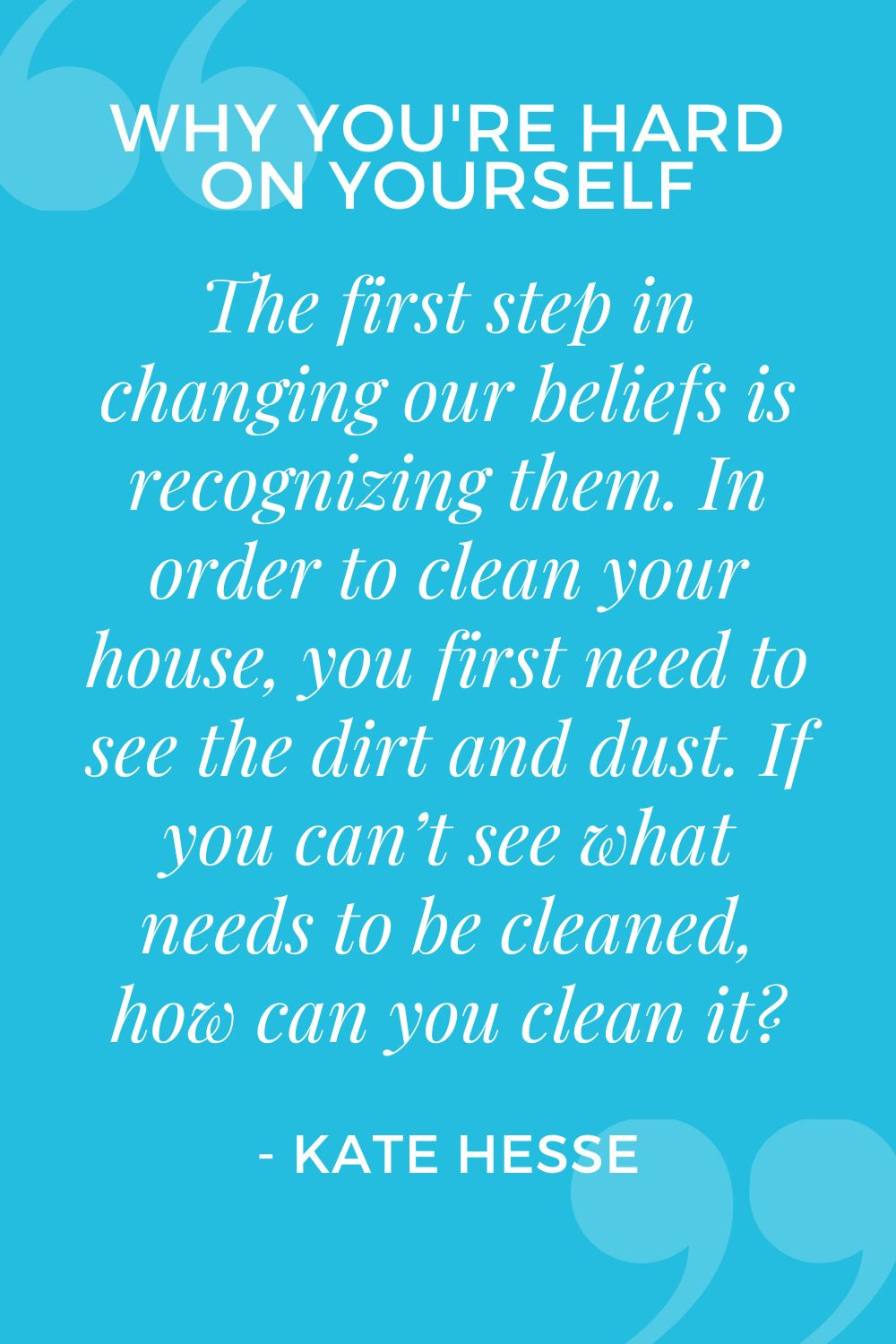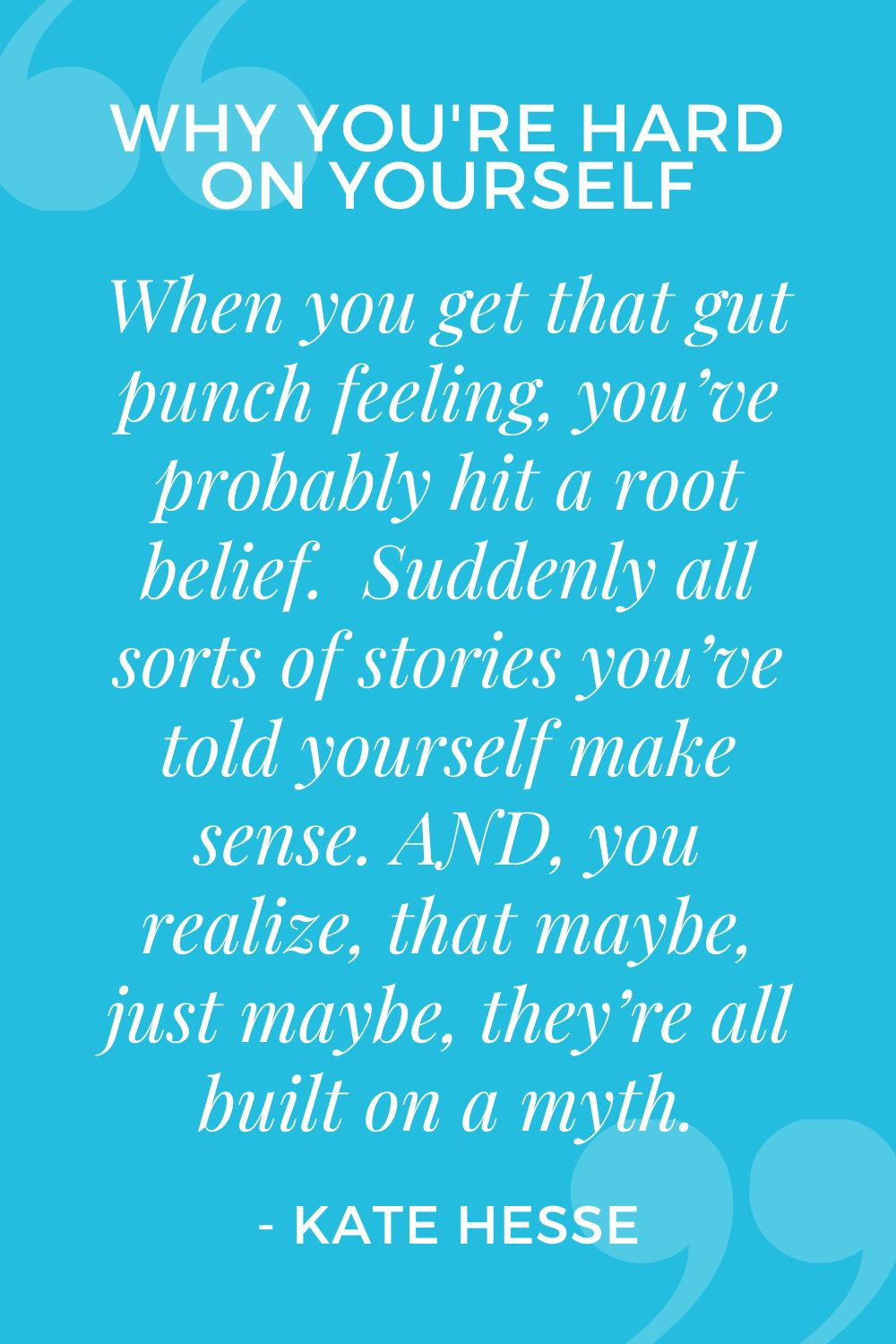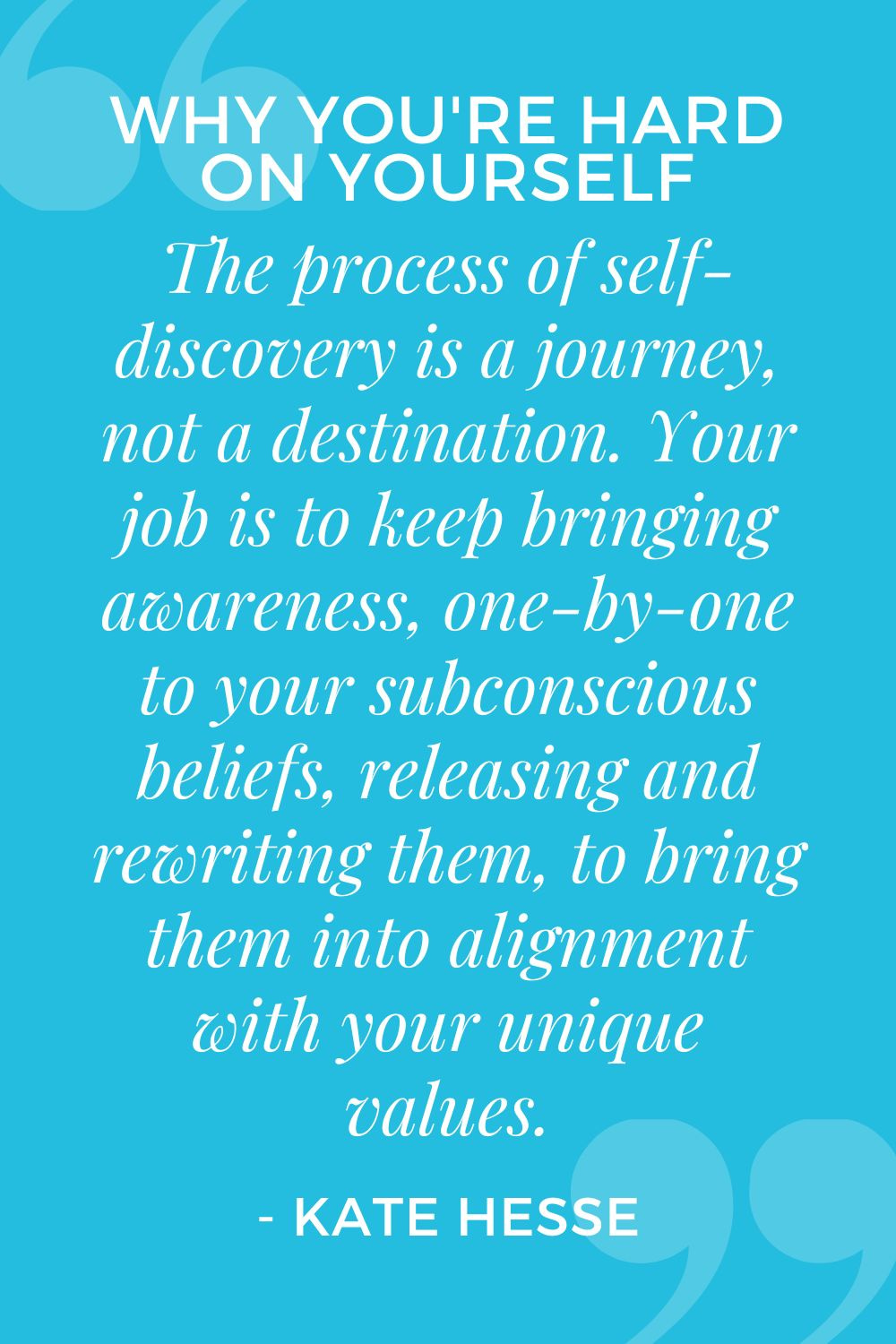
In order to be hard on yourself, you have to start with the belief that you’re falling short somehow. Falling short of your expectations for yourself, of other’s expectations for you, of what you believe society expects you to be and do.
At the core of this self-criticism is our beliefs. The beliefs often aren’t true, and just as often we aren’t even aware of them as they run in our subconscious. Think of them like malicious software running in your computers unnoticed until it starts to cause major problems.
 Let’s start with what a belief is. . .
Let’s start with what a belief is. . .
Your beliefs are stories you tell yourself – often unconsciously – that aren’t actually true. I’ve started to refer to our beliefs as myths – using the non-allegorical definition of a commonly held but false belief or idea.
Our beliefs are like code running in our subconscious, influencing many of our thoughts, actions, inactions, and emotions. And when your beliefs are actually myths, they can negatively impact many aspects of your life.
The myths fill your to-do list with things you don’t actually care about. Cause you to be hard on yourself when you don’t meet expectations for yourself you don’t actually want to meet. And swaying your ideas about how you should be spending your time by guilting you into interactions out of alignment with what’s actually important to you.
And all of that results in feelings of frustration, guilt, shame, self-doubt, self-blame, overwhelm, and burnout. Think of it like trying to swim against the current, if you just turned in the other direction, everything would be so much easier!
 Where do our beliefs come from?
Where do our beliefs come from?
We acquire beliefs through a number of different sources:
Our Family
These are things we learn either from what our family says (or doesn’t say), or by watching the way they act and interact with us and others.
Culture & Society
Beliefs in this category are picked up from people you know personally as well as the media you consume – your social feed, television and movies, the news, magazines, advertising, etc. Again, these beliefs are conveyed both through what’s actually said as well as what you observe.
Correlation without Causation
This source of beliefs follows along the lines of Plato’s Cave. If every time you got out of bed on the left side it was sunny, and every time you got out of bed on the right side it was cloudy, you might believe you control the weather.
Perhaps in reality the morning sun shining in the window on the right side of the bed causes you to roll over toward the left before waking up. Then you naturally climb out of bed on the left side. On cloudy days, nothing causes you to roll over so you get out on the right – the side you naturally sleep on.
While this is a low-cost example, there are plenty of places where we believe our thoughts or actions have caused a result to manifest – even though the two were not actually related the way we believe.
Understanding your beliefs – the nesting doll analogy
Usually when I talk about uncovering and understanding your beliefs, I use the analogy of a head of lettuce or cabbage – a densely packed ball with layer upon layer to peel back. But in my own self-work, I’ve started to use the analogy of nesting dolls.
I’m sure you can picture what I’m talking about – the sweet little bowling pin shaped dolls that split open around the waist, and have a slightly smaller, similar but not identical, version of themselves inside.
 What do nesting dolls have to do with beliefs?
What do nesting dolls have to do with beliefs?
The first step in changing our subconscious beliefs is recognizing them. Think about it like this – in order to clean your house, you first need to see the dirt, dust, and cobwebs. If you can’t can’t see what needs to be cleaned, how will you clean it?
As you dive into this type self-work, the first belief you land on is often a symptom of a deeper belief. And to discover that deeper root belief, you need to open the dolls to uncover what’s under that first shell.
Here’s an example of what this might look like in practice:
- Belief: I need to clean my house every other day.
Why?
- Belief: I’m afraid if I don’t keep the house clean my husband will stop loving me.
Why?
- Belief: Because it’s what a wife is supposed to do.
And if you don’t?
- Belief: Then people will think less of me.
And?
- Belief: I don’t want people to think less of me.
Why?
- Belief: Because then they might not want to spend time with me.
Because?
- Belief: Because people only want to be with me, or spend time with me, if I’m doing something for them.
Picture each of those beliefs as a nesting doll – as you open each one, you find another belief nested within. And when you reach that last belief – that’s what I call a root belief. It’s the foundation that other beliefs are based on.
And if you believed people only wanted to be with you or spend time with you if you were doing something for them, think of how many things it would cause you to put on your to-do list beyond cleaning the house every other day.
When you get that gut punch feeling, you’ve probably hit a root belief. It’s like the last tumbler falling into place in a lock and suddenly all sorts of stories you’ve told yourself make sense. AND, you realize, that maybe, just maybe, they’re all built on a myth.
 Uncovering your beliefs
Uncovering your beliefs
I’ve got a great exercise to help you dig in and uncover your subconscious beliefs which are actually myths.
As you work through the questions, consider if the belief you’ve identified is a symptom belief, or a root belief. If it’s a symptom, ask yourself why it matters or what might happen if you didn’t align with the belief.
And if this feels like something you’re not sure you can tackle on your own, I’m here to support you.
The dialogue above is similar to what a coaching session with me would look like if we were working on beliefs. I’d be there to ask the questions to guide you from the first surface belief, down to the root belief it was a symptom of. And then to help you understand how to use that awareness to shift the belief to bring more freedom, resilience, serenity, and joy into your life.
You can learn more about my Individual Coaching program and schedule a no-cost Discovery Session with me to start the conversation.
 Let’s get back to the nesting dolls
Let’s get back to the nesting dolls
Sometimes in the process of cracking open a root belief to recognize and release it, you discover that nesting doll was actually hiding yet another doll inside or behind it.
What that means is even after you’ve identified and addressed a root belief, it’s not uncommon to discover in future work another root belief hiding well below the original which couldn’t be seen until the first was removed.
This happened to me recently. I realized a belief I’d worked hard to release and rewrite was gone. And in its place sprung up a deeper adjacent belief. Once I brought awareness to this new belief, I took time to both celebrate the work I’d put into releasing the first belief, and then created a plan to begin weeding out this newly discovered belief.
The process of self-discovery is a journey, not a destination. There won’t be a time where I’ll be able to say – yes – I’ve finally discovered and addressed all my subconscious beliefs. Instead, I’ll keep bringing awareness, one-by-one to them, and working to release and rewrite the beliefs to bring them into alignment with my unique values.
Getting started examining your beliefs
If this work resonates with you and you’d like to create your own process for self-discovery, check out my birthday retreat. You don’t need to wait for your birthday to dive into this work (although it’s a great annual check-in) just pick a day or weekend and set aside several hours to begin diving into discovering your beliefs, unique values, and how to begin to bring everything into alignment.
Does this all feel overwhelming? I get it! And I’m here to help break it down into actionable steps that are right-sized for you and your life! Learn more about working with me 1:1 in my Individual Coaching Program.
Related
Leave a Reply Cancel reply
This site uses Akismet to reduce spam. Learn how your comment data is processed.